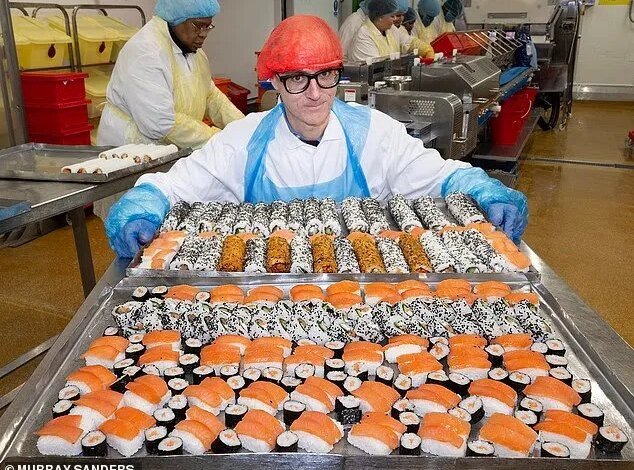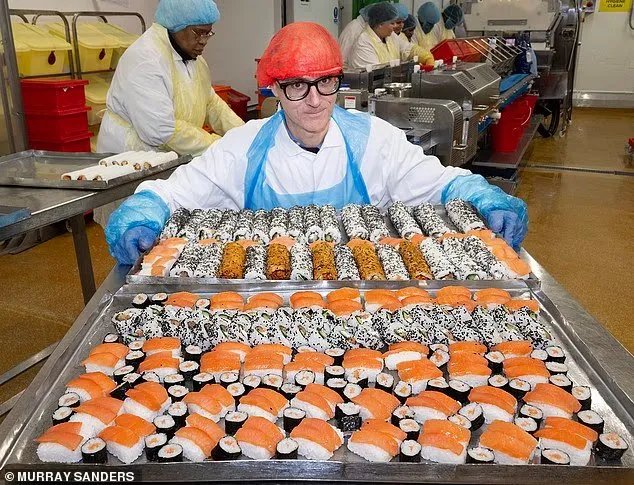Fishy Truth About Your Supermarket Sushi No Raw Salmon. Rice From Australia. And Lots Of Chicken. HARRY WALLOP Visits The Factory And Finds Out Exactly What Goes In

Fishy Truth About Your Supermarket Sushi No Raw Salmon. Rice From Australia. And Lots Of Chicken. HARRY WALLOP Visits The Factory And Finds Out Exactly What Goes In
If you are an office worker, there’s a strong chance you’ll have chosen neither salad nor a sandwich for lunch this week, but plumped for a tray of supermarket sushi.
Sales of the Japanese speciality are booming, with one leading research company reporting that the UK market has seen an astonishing 27 per cent growth in the past 12 months alone.
Today, Marks & Spencer sells sushi than salads and pasta combined as a lunch option, and Lidl offers 23 different sushi boxes, outnumbering its 21 different sandwiches and wraps.
Yet if you bought your sushi from Britain’s biggest retailer, Tescoit will have been made by a company called Ichiban in the decidedly un-Japanese location of Earl Stonham, a small Suffolk village with a beautiful 15th century church.
the و a و sushi – تفاصيل مهمة
And it will have been put together in a factory where the biggest ingredient is neither salmon nor tuna, but chicken along with rice imported from… Australia.
Welcome to the strange yet wildly popular world of supermarket sushi.
To find out how this once exotic dish has become a weekday staple for millions of Brits – and exactly how it is made – I pulled on a hair net and made my way to the medieval village known these days as sushi central.
Harry Wallop: I pulled on a hair net and made my way to the medieval village known these days as sushi central
to و the و a – تفاصيل مهمة
Sales of the Japanese speciality are booming, with one leading research company reporting that the UK market has seen an astonishing 27 per cent growth in the past 12 months alone
The first big surprise is that Ichiban gets through three tonnes of salmon a week – but none of it is raw. It turns out that the vast majority of Brits don’t actually like raw fish.
Instead, Ichiban’s salmon is smoked or cured with salt and sugar. This is both to preserve the raw appearance and to make it acceptable to British tastebuds.
Isn’t that a bit misleading, when most people associate ‘sushi’ with ‘raw fish’ – as the Japanese eat it?
is و that و of – تفاصيل مهمة
No, says Natasha Younger, the new product development manager at Ichiban, who is showing me round the factory.
‘In fact, 90 per cent of the consumers assume that smoked or cured is raw,’ she says.
Indeed, Ichiban goes to the trouble of putting a statement on the back of sushi packs to say the contents are unsuitable for pregnant women – even though cured fish is perfectly fine for them to eat. Perceptions matter and the supermarkets would rather avoid a stream of needless complaints.
Nearly all seafood sushi in supermarkets – including Tesco, the Co-op, Aldi and Sainsbury’s – is either smoked, cured or, in the case of tuna and prawns, cooked.
the و of و cured – تفاصيل مهمة
Aside from changing the taste, curing and cooking help to kill off bacteria. ‘Supermarkets can’t handle the risk of microbial growth,’ explains Younger.
The small number of supermarkets that do use raw salmon – including Waitrose and M&S – have to freeze it beforehand to comply with Food Standards Agency regulations. The FSA insists on all sushi fish sold in supermarkets being frozen to -20C for at least 24 hours to kill bacteria.
Ichiban owner Bob Baker and his wife Trish
Fish arrives frozen at the Earl Stonham factory, too, even though Ichiban only supplies smoked and cured salmon.
to و and و The – تفاصيل مهمة
Freezing helps extend the shelf life. Also, it’s easier to cut fish when its partially frozen, says Mark Turner, commercial director of the Wonderfield Group, the company that makes all of Yo! packaged sushi, as well as the Taiko brand sold in Waitrose.
I watch as one worker, Poalo, uses an extremely sharp knife trim the brown meat off one frozen side of salmon – already de-boned by the time it arrives – then slice it into four fillets, each about 18 inches long. These are placed on a conveyor belt that takes them through the cutting machine. A laser measures the thickness of the flesh, then adjusts a set of blades to ensure each resulting slice of salmon weighs exactly seven grams.
By the time the slabs of fish emerge, 15 perfect slices have been created ready to be used for nigiri. This is the most famous type of sushi – a slice of fish draped over a small block of rice.
Sushi literally means ‘vinegared rice’, and rice is easily the most important component in the process. Ichiban gets through 48 tonnes of cooked rice a week, a quantity dwarfing the three tonnes of salmon it handles.
the و of و a – تفاصيل مهمة
I am ushered into the rice room and watch as a steady supply of fluffy, cooked rice emerges from the oven on a conveyor belt then falls into plastic red tubs, each holding about 12.5kg (2st).
The rice is a short-grain variety grown in Australia which turns out to be the main ingredient in all UK supermarket sushi. Australia has the space, the water and the sophisticated harvesting machines to supply rice at scale – and an acceptable price.
‘It’s high quality and it’s cheap,’ says Younger. ‘Japanese rice is much, much expensive. We couldn’t afford it, no retailer could.’
The Daily Mail’s photographer is not allowed to take pictures of the rice oven which, costing nearly £2million, remains top secret.
the و rice و is – تفاصيل مهمة
‘We’re ahead of all the competition with this,’ explains Alex Faulkner, the head of production. I am, though, allowed to peer into the machine and inspect the tiny nozzles spraying the vinegar over the cooked rice. This is what gives sushi rice its distinctive, slightly sour flavour.
But it also plays a useful safety role. By making the rice acidic, the vinegar stops bacterial growth and extends the shelf life.
The rice is also sprayed with a small amount of rapeseed oil so it is sufficiently malleable to get through the processing machines.
Next, the rice is wheeled to sit in a cooling room before it is sent to a machine which turns it into little blocks for nigiri.
the و it و a – تفاصيل مهمة
The cooked rice, poured into the top of the machine, is pressed – like tonnes of plasticine – into 20-gram blocks at a rate of 12,000 an hour.
Freezing helps extend the shelf life. Also, it’s easier to cut fish when its partially frozen, says Mark Turner, commercial director of the Wonderfield Group
Only some of the rice ends up this way. Another popular type of sushi is the maki roll – when a sheet of seaweed is wrapped around the rice which is, in turn, wrapped around a filling – sometimes fish, sometimes vegetables – and rolled into a log shape, then cut to create colourful wheels.
We move into the ‘machine room’ where five workers stand at a conveyor belt and swiftly, but steadily, assemble an enormous maki roll ten metres long.
the و of و a – تفاصيل مهمة
‘This is where the magic happens,’ says Faulkner. ‘It is essentially a handmade product.’
He is right – though a big machine is involved, too – and it is mesmerising to watch.
First a huge roll of nori – the green sheet of seaweed – is loaded on to the machine.
Ninety yards long, the roll spools out along a slow-moving conveyor belt while rice is gently pushed on top by a machine.
is و – و a – تفاصيل مهمة
The filling is added by human hands, with each worker grabbing a bit and placing it onto the rice and seaweed, before the next worker in the line adds some .
Jess, the supervisor, originally from the island of Sao Tome and Principe off the coast of Liberia, says it takes at least a week to train workers to do this accurately.
The workers in this room come from Portugal, Poland, Romania, Lithuania and Cape Verde.
As the conveyor belt approaches the end of its run, the two edges bend inwards, rolling up the contents and producing a never-ending sushi tube.
the و of و and – تفاصيل مهمة
This then moves into a cutting machine, which slices the tube into ten-inch chunks. These are then cut into eight separate – colourful – wheels and packed, by hand, into plastic trays.
Despite the machines used to cook, roll and cut the sushi, humans are needed to fill and pack it
In a three-hour shift, the workers will make 5,800 logs and 46,000 separate pieces of maki roll sushi.
A machine is used to place the lid on each tray and print the best before date – four days from when it was made – before the sushi is loaded on to refrigerated lorries and taken to distribution warehouses around the country.
the و to و and – تفاصيل مهمة
They arrive on Tesco shelves the following morning, giving each pack a three-day life on sale.
The maki roll I’ve been watching is in fact a Korean-style chicken ‘dragon roll’. The filling has nothing to do with fish and is made from breaded chicken, which has been chopped up and mixed with spicy mayonnaise.
Which brings us to the next surprising fact about supermarket sushi. Namely, the most popular ingredient by weight – after the rice – is no longer salmon, but chicken. Ichiban gets through four tonnes of it every week, compared to three tonnes of salmon.
‘In the last 12 or 18 months, the British consumer has embraced chicken,’ says Faulkner. ‘Ten years ago, (Sushi) was very Japanese but now it’s “fusion”.’
the و is و has – تفاصيل مهمة
He reckons the increasing use of chicken has helped win over a new market. It is a view shared by Kathryn Turner, director of product development at M&S Food, which has recently launched a chicken Caesar dragon roll. It rapidly became one of its best sellers.
‘This flavour is a great entry point into sushi – where people may not like raw fish but want to have something lighter than a sandwich or want to dip their toes into sushi as a cuisine,’ she says.
Young consumers have embraced East Asian trends in the last few years, with Japanese anime cartoons, Korean bubble tea, Korean pop music and Labubu dolls, originally from Hong Kong, all now hugely popular.
Another key reason why sushi has taken off is because it is now incorporated into so many of the supermarkets’ lunchtime deals.
is و a و into – تفاصيل مهمة
Tesco introduced Tesco Finest sushi into its £5.50 premium meal deal this year, which also meant both the Itsu and Yo! brands got prominent space on the supermarket shelf as you walked in.
Ichiban’s finished products: ‘The whole point of sushi is that it should be colourful, it stands out on the shelf’
The single most popular ‘snack’ in the £5 Waitrose Food To Go Meal Deal is not a bag of crisps or cereal bar but sushi: Taiko chicken katsu bites – bits of breaded chicken with a spicy mayo dip.
Red peppers are another Ichiban staple, appearing in many of the dishes as a topping or as part of the filling. Ichiban gets through even peppers and cucumbers – by weight – than salmon or chicken.
of و the و a – تفاصيل مهمة
‘The whole point of sushi is that it should be colourful, it stands out on the shelf,’ says Younger.
But it is also undeniable that the vegetables are far cheaper than protein. And, with prices of meat and fish soaring, this is a useful way of keeping costs down.
For example, the Korean dragon rolls, by weight, are 62 per cent rice, 17 per cent vegetables and only 7 per cent chicken.
But the most significant cost of all is the Ichiban workforce of some 350 people.
the و of و is – تفاصيل مهمة
‘Our biggest challenge is increasing labour costs. The increase in National Insurance and in everything else (including minimum wage) has really hit us,’ says Faulkner.
Despite the machines used to cook, roll and cut the sushi, humans are needed to fill and pack it.
‘You can’t automate this stuff. It is too delicate,’ he explains. ‘Robots, no matter how gentle they are, can’t do what a human could do.’
And that, in an age of AI, is strangely comforting.
the و to و and – تفاصيل مهمة
Disclaimer: This news article has been republished exactly as it appeared on its original source, without any modification. We do not take any responsibility for its content, which remains solely the responsibility of the original publisher.
Disclaimer: This news article has been republished exactly as it appeared on its original source, without any modification.
We do not take any responsibility for its content, which remains solely the responsibility of the original publisher.
Author: uaetodaynews
Published on: 2025-11-08 01:44:00
Source: uaetodaynews.com





